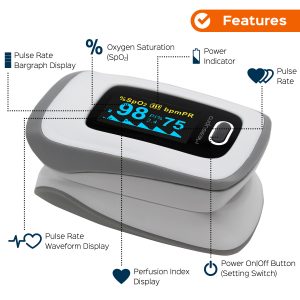Pulse Oximeter – A Saviour in COVID-19
Top 7 Pulse Oximeters and why you need it now
When a friend of mine recently became critically ill with what seemed to be coronavirus infection, my first question to her was about the timeline. “How many days ago did you notice your symptoms?” I asked her if she has a Pulse Oximeter? She asked me, “What is that?”
Keeping track of your illness is very important. Mark your calendar right from day one if you feel you have developed symptoms associated with Covid-19. Specifically, monitoring of symptoms like fever and oxygen saturation levels is an important parameter to note especially in the first 5 to 10 days of starting of symptoms.
The pattern of Covid-19 symptoms
Although this deadly pandemic has been unpredictable in the range of symptoms it causes, it often follows a consistent pattern. It usually occurs in two phases. According to Dr. Ilan Schwartz, Assistant professor of Infectious Diseases at the University of Alberta, most patients recover in about a week, but a significant few enter “a very vicious second phase” of illness. “After the initial symptoms, things plateau and maybe even improve a little bit, and then are secondary worsening.”
What do doctors say?
While every patient is different, doctors say that days five through ten of illness are often the most worrisome. The respiratory complications of Covid-19, particularly for older patients, those with immune-compromised systems like cancers, and those with underlying conditions like high blood pressure, diabetes, or obesity. Younger patients may start to show symptoms a little later, as late as days 10 to 12. Those who reach day 14 without any tormenting symptoms (other than feeling miserable and fatigued) are likely to be on the road to recovery.
According to Dr. Leora Horwitz, associate professor of population health and medicine at N.Y.U. Langone Health, symptoms of any other disease will get better after a week. But it’s different with Covid-19. “With Covid-19, I tell people that around a week is when I want you to pay attention to how you’re feeling. Don’t get complacent and feel like it’s all over.” He said.
When to call your doctor?

Call your doctor if you feel shortness of breath or any other concerning symptom. It doesn’t matter what day of illness you are on. Don’t panic if you still feel lousy after a week of illness. Covid-19 symptoms linger and feeling unwell for more than a week doesn’t always mean that you need medical treatment.
But urgent attention is being paid by the doctors as the illness nears its second week with patients arriving at hospitals with an insidious form of pneumonia.
Why is Pulse Oximeter a Saviour?
On scans, patients with COVID pneumonia have “ground-glass opacities,” a hazy appearance found in the lower part of both lungs. Oxygen levels drop slowly that the patient doesn’t even notice. This condition is called “silent hypoxia.” Often it is not until oxygen saturation reaches dangerously low levels. It leads to severe shortness of breath that needs to be taken care of. The best way to monitor your symptoms during this time is to use a pulse oximeter.
To know more about silent hypoxia, click on the video
What is a pulse oximeter?

A pulse oximeter is a small device that clips on your finger and measures your blood oxygen levels. The normal oxygen saturation level is about 96 to 99 percent. It sends a beam of light through your finger. As we all know that oxygenated blood is not the same color as deoxygenated blood, the amount of light transmitted is directly proportional to the concentration of oxygen in the blood. It tells you how much your blood is oxygenated. The pulse oximeter will not tell you what’s wrong with your body but it will tell you if your breathing is okay. There is a huge difference in coughing with an oxygen saturation level in the ’90s and having it in ’70s with the same cough. You can afford to lose some lung function while breathing in the ’90s and still be okay. Once you start descending into the ’70s, you are at the cliff of the sheer drop. The slightest drop in your lung function further can be very fatal.
This is where the pulse oximeter comes to your rescue. As soon as your blood saturation goes below 90% and it continues to go down, rush to your doctor immediately. Don’t wait for it to reach the 70’s. you can also call an ambulance.
There are many phone-based apps meant to do this, but they perform poorly.
Top 7 Pulse Oximeters On Amazon
How to increase oxygen flow at home?

While at home, you can increase the flow of oxygen by lying on your stomach. It opens parts of the lungs that are compressed while lying on your back. You can also rest on your left side or right side, or sit upright in a chair to increase the flow of oxygen to your lungs.
Dr. Anna Marie Chang, an associate professor of emergency medicine and director of clinical research at Thomas Jefferson University, was sick for about a week before her oxygen levels dropped to 88 on the ninth day of her illness; she was then treated with oxygen and rested mostly in the prone position for four days to recover. Although Dr. Chang cautioned the patients that every human body is different and does not follow the perfect manual. So, listen to your body and do not be too strict about following a timeline of symptoms.
Bottomline of the Public Health Department
According to the doctors, the problem lies with the guidelines issued by the public health department. It tells the patient to ride out the illness at home and seek medical help only if they experience severe shortness of breath. As a result, too many patients are waiting too long to contact a doctor. According to Dr. Richard Levitan, a well-known emergency room doctor from New Hamshire, the widespread use of pulse Oximeters at home during the first two weeks of Covid-19 illness will help you track your symptoms. Remember, toughing it out is not a great strategy.
How to get a pulse oximeter?
You can buy a pulse oximeter from a medical equipment store (if open) or you can order it online from amazon. A variety of pulse Oximeters are available suiting your pocket. Some medical practices are also sending their patients home kits that include pulse ox. So, check with your doctor to see how you can be monitored. You may ask also your friends and relatives if they have a pulse oximeter so that you can borrow one for some time. You can sanitize the device easily.
To know how to sanitize the Pulse Oximeter, click here
If you still feel under the weather and don’t have a pulse oximeter, you can also check it with an urgent care clinic.
To know how to use Pulse Oximeter, click here
You may also like



